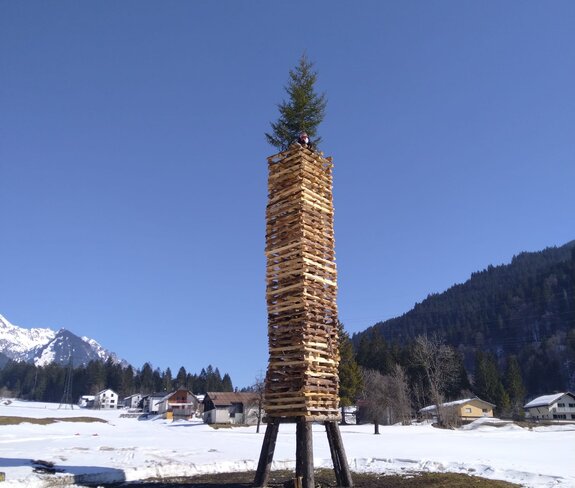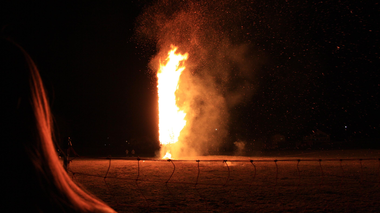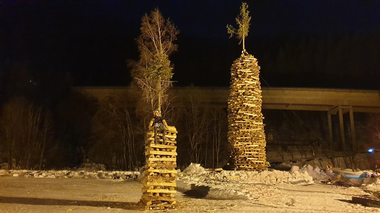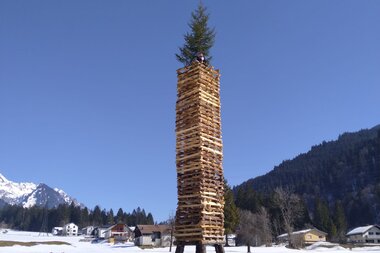
From mystical traditions
The spark fire
If you are out and about in Vorarlberg on the first weekend after Ash Wednesday, you will be amazed to see burning towers and impressive fires everywhere. The evening before, there are piles of wood everywhere, which are guarded around the clock.
What is this spectacle all about?
The traditional burning of sparks is an ancient Swabian-Alemannic tradition whose origins are not fully understood. Some people may think that the burning of wooden towers and witch dolls is a remnant of the terrible witch burnings in the early modern era, but this is a misconception! The origins of the fires can be found in ancient pagan fertility rites with sacrificial fires, as well as in the end of the Swabian-Alemannic carnival and the beginning of Lent. In Vorarlberg, the practice of Bonfire Sunday has a long tradition; in almost every municipality, a bonfire is organized by the local spark guild, the local fire department or the carnival guilds. In 2010, Vorarlberg's Spark Sunday was even included in the world cultural heritage list.
Every year on Spark Sunday, the so-called spark fir is lit. This is a piled-up wooden tower made from collected materials, such as old Christmas trees. According to popular belief, the sparks are supposed to drive away winter and ignite happiness. The winter witch, which is attached to the top of the spark, symbolizes the beginning of spring. It is usually prepared with black powder so that it can explode in the fire. Once the spark is lit, the spark master gets nervous... and not without reason! He waits for the witch to explode - if this doesn't happen, she has to be buried the next day.
In Vorarlberg, Spark Sunday has a second name: Küachlisunntig - the name says it all! The delicious little cakes made from yeast dough, refined with powdered sugar, not only make the hearts of Funkenzunft members beat faster. Funkaküachli are a must when visiting the Funken - and if you can't get enough of them, you can easily bake them at home - click here for the recipe.
There are numerous exciting customs surrounding the Funkenfeuer, which are carried out differently in each valley - and even in the individual villages.
Each member 13 bushes!
In Braz, there is a very special custom that every member of the Funkenzunft must pay as a membership fee: 13 "Buschel"! But what is this?
The spark in Braz is traditionally built with wooden bushes, which are tied from branches of various types of wood. In the middle of the spark, the approx. 20m high spruce tree is anchored in the ground. The bushes are tied around the fir tree with wire. An incredible 420 bushes are needed for one spark! In addition to the sparkler fir and the bushes, the sparkler is filled with pallets and old Christmas trees, with the sparkler witch hanging at the top. The spectacle is accompanied by torchlight swinging.
No nails, no screws!
In Dalaas, Wald am Arlberg and Klösterle, the sparkler towers are not made from old Christmas trees like in most other communities - the construction method invites you to marvel. Without nails, screws or other fastening materials, a wooden tower made of logs is stacked upwards and the spark witch is attached to the top. The exact technique differs from village to village - while a square tower is built in Dalaas, the hexagonal construction method is used in Wald am Arlberg.
Children's sparks in Klösterle
In Klösterle, the afternoon of Spark Saturday is a very special day for the youngest members of the community. Traditionally, there is the so-called "children's spark": torches are built under the expert guidance of the spark master, with which the children are allowed to light the tower on Spark Sunday. To ensure that no one gets ahead of the children, the spark tower is guarded around the clock by the spark guard after completion.
Sources:
Vorarlberg Tourismus, Wikipedia, UNESCO Funkensonntag, Funkenzunft Braz, https://cdn3.vol.at/2008/03/Infos_funken.pdf, Funkenzunft Dalaas, Funkenzunft Klösterle, Funkenzunft Wald am Arlberg, Heimatleuchten: Wild Winter







